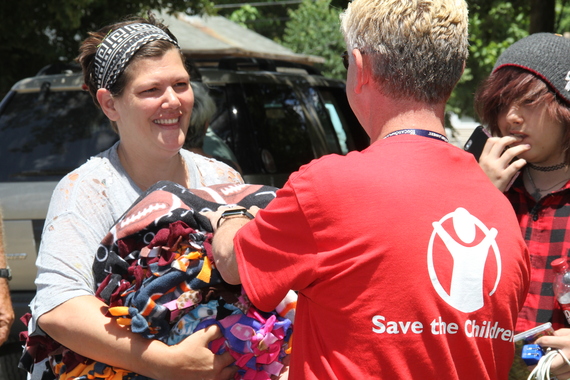The Ice Age: Collision Course herd joins Save the Children to help families stay connected
Save the Children is on the ground providing disaster relief in West Virginia after deadly floods devastated some of America's most deprived communities. Photo by Tom Riser / Save the Children.
As we all watched flood waters envelop parts of West Virginia this past week, destroying family homes and schools in their wake, I was once again reminded how disaster can strike at any time.
Thousands of children were impacted by the flooding, and there's no telling how many might have been separated from their parents in those initial moments.
It can be very scary for a child and parent to be apart during emergencies, but families can take some simple steps now to get prepared to quickly reunite after disaster hits.
Save the Children has teamed up with 20th Century Fox and the entire Ice Age: Collision Course herd this summer to help keep children safe in such times of crisis.
In a new animated PSA, the Ice Age herd shows how ICE contact cards can keep families together. The PSA encourages parents to create ICE (In Case of Emergency) cards for their children, so families can get back together swiftly after an emergency.
The message is critical, as millions of children are separated from their parents every day while at summer camp or daycare.
And with recent research from the National Center for Disaster Preparedness at Columbia University showing that more than 40 percent of American families do not know where their child will be evacuated in case of an emergency, the ICE card is an urgent resource for families this summer - a season known for wildfires and hurricanes.
Here are five ways parents and kids can get prepared together, using the PSA from Save the Children and 20th Century Fox:
Break the ICE: watch the PSA and ask your child what they think the message is.
Talk about why: Talk about the top disaster risks in your area, and explain that it's important to have a plan to reunite quickly during emergencies. Letting children know you're planning ahead to keep them safe helps them feel safe - both before and during an emergency.
Talk about who: Each child should have three emergency contacts that any camp counselor, teacher or caregiver can reach out to. Since local power and phone service can be disrupted during emergencies, it's important to have one out-of-town contact as well. Practice learning these numbers with your child.
Make the ICE cards together: Enter the three contacts along with your child's medical info at www.SavetheChildren.org/ICE, upload a photo and print out your cards at home.
Keep them within arms' reach: You'll get two copies of your child's card. Discuss the bag, wallet or other place where you each will keep yours so it will always be nearby.
The PSA and these tips provide a way for parents to open up a dialogue with their children on emergency planning -- the first line of defense in a disaster.
I'm proud to say Save the Children - which already runs long-term education programs for vulnerable children in West Virginia -- is now helping support the immediate needs of families impacted by the flooding there. At the same time, we want to help all families be better prepared before a disaster unexpectedly turns life upside down. Creating ICE cards for each child and discussing emergency plans before disaster strikes can go a long way.
Disasters are going to happen, but it's how we prepare for them that makes all the difference.
